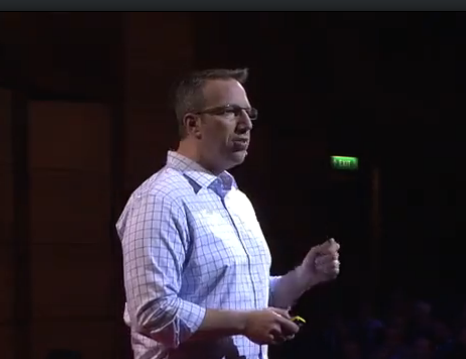We consistently underestimate what criminals and terrorists can do.
我们一直低估了罪犯和恐怖分子能做到的事情。
Technology has made our world increasingly open, and for the most part, that's great, but all of this openness may have unintended consequences.
科技已经让我们的世界越来越开放。当然,在大多数情况下,这是好事,但是这个开放性也可能会造成始料未及的后果。
Consider the 2008 terrorist attack on Mumbai. The men that carried that attack out were armed with AK-47s, explosives and hand grenades.
想想看2008年发生在孟买的恐怖袭击吧。那些实施了那次恐怖袭击的人都装备着AK-47s,炸药和手榴弹。
They threw these hand grenades at innocent people as they sat eating in cafes and waited to catch trains on their way home from work.
他们把这些手榴弹投向了那些正在咖啡馆里就餐和下班后正在等着赶火车回家的无辜的平民。
But heavy artillery is nothing new in terrorist operations. Guns and bombs are nothing new.
但是在恐怖活动当中,重型火炮早已屡见不鲜。枪支和炸弹更是毫无新意了。
What was different this time is the way that the terrorists used modern information communications technologies to locate additional victims and slaughter them.
这次恐怖袭击的特殊之处在于,恐怖分子利用现代信息通信技术,查明额外的受害者的身份并且屠杀他们的方式。
They were armed with mobile phones. They had BlackBerries. They had access to satellite imagery.
这些袭击者配备了移动电话。他们拥有黑莓手机。他们可以使用卫星地图。
They had satellite phones, and they even had night vision goggles. But perhaps their greatest innovation was this.
他们拥有卫星电话,甚至夜视眼镜。但是他们最大的创新之处也许是这个:
We've all seen pictures like this on television and in the news. This is an operations center.
我们都在电视上或者新闻里看到过像这样的图片。这是一个操控中心。
And the terrorists built their very own op center across the border in Pakistan, where they monitored the BBC, al Jazeera, CNN and Indian local stations.
这些恐怖分子建立了完全属于他们自己的,跨越巴基斯坦边境的操控中心,在那里,他们可以监控英国广播公司,半岛电视台,美国有线电视,以及印度当地的地方电台。
They also monitored the Internet and social media to monitor the progress of their attacks and how many people they had killed. They did all of this in real time.
他们还可以通过监测网络和社会化媒体来监控他们的袭击的进展,以及他们已经屠杀了多少人,他们实时进行着一切行动。
The innovation of the terrorist operations center gave terrorists unparalleled situational awareness
恐怖分子在操控中心上的创新,为他们提供了前所未有的现场情景感知
and tactical advantage over the police and over the government. What did they do with this? They used it to great effect.
以及远胜过警察和政府的战术优势,他们利用它做了什么呢?他们利用它发挥了重大的作用。

At one point during the 60-hour siege, the terrorists were going room to room trying to find additional victims.
在60个小时的恐怖袭击过程中,这些恐怖分子曾一度闯入一间又一间的房间,试图寻找更多的受害者。
They came upon a suite on the top floor of the hotel, and they kicked down the door and they found a man hiding by his bed.
他们在酒店的顶层偶然发现一间套房,接着他们踢开了房门,而且找到了一个正躲在床边的男人。
And they said to him, "Who are you, and what are you doing here?" And the man replied, "I'm just an innocent schoolteacher."
他们问这个男人:“你是谁,你在这里干什么?”这个男人回答道:“我只是一名无辜的学校老师。”
Of course, the terrorists knew that no Indian schoolteacher stays at a suite in the Taj.
当然,这些恐怖分子非常清楚,印度的学校老师不可能住得起泰姬玛哈酒店的套房。
They picked up his identification, and they phoned his name in to the terrorist war room,
他们捡起了他的身份证件,并且打电话将他的名字告知了恐怖活动操控中心,
where the terrorist war room Googled him, and found a picture and called their operatives on the ground and said, "Your hostage, is he heavyset?
而操控中心的恐怖分子在谷歌上搜索了他的名字,找到了一张照片,然后把电话打回给在套房现场的恐怖分子,并且问他们:你们的人质是不是身材壮硕?
Is he bald in front? Does he wear glasses?" "Yes, yes, yes," came the answers.
他的前额是不是秃顶?他是不是戴着眼镜?”“没错!”现场的恐怖分子回答道。
The op center had found him and they had a match. He was not a schoolteacher.
操控中心找到了他,并且对他的身份进行了匹配确认。他的确不是学校老师。
He was the second-wealthiest businessman in India, and after discovering this information, the terrorist war room gave the order to the terrorists on the ground in Mumbai. ("Kill him.")
事实上,他是印度财富排名第二的商人,而在发现了这一信息之后,操控中心给孟买现场的恐怖分子下了一道命令。(“杀了他。”)












